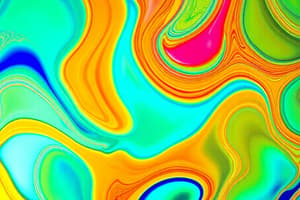Podcast
Questions and Answers
What is the primary function of the electrolyte in electrochemical machining (ECM)?
What is the primary function of the electrolyte in electrochemical machining (ECM)?
- To maintain a specific pH level for the chemical reaction
- To carry off the material removed from the workpiece (correct)
- To act as a coolant and remove heat from the process
- To provide a conductive medium for electrical current
Which of the following statements about the electrode in ECM is true?
Which of the following statements about the electrode in ECM is true?
- The electrode is gradually lowered into the workpiece during the process (correct)
- The electrode shape is the same as the desired final part shape
- The electrode is connected to the positive terminal of the power supply
- The electrode material must be an insulator
What is a typical voltage range used in electrochemical machining?
What is a typical voltage range used in electrochemical machining?
- 50-100 V
- 100-500 V
- 1000-5000 V
- 5-25 V (correct)
Which of the following materials is commonly used for the electrode in ECM?
Which of the following materials is commonly used for the electrode in ECM?
What is the primary advantage of electrochemical machining compared to traditional machining processes?
What is the primary advantage of electrochemical machining compared to traditional machining processes?
Which of the following electrolytes is commonly used in electrochemical machining?
Which of the following electrolytes is commonly used in electrochemical machining?
What is the main advantage of electrochemical machining (ECM) compared to conventional machining?
What is the main advantage of electrochemical machining (ECM) compared to conventional machining?
What is the primary application of electrochemical deburring (ECD)?
What is the primary application of electrochemical deburring (ECD)?
What is the main difference between ECM and ECD in terms of material removal?
What is the main difference between ECM and ECD in terms of material removal?
What is the purpose of the electrolyte flow in electrochemical deburring (ECD)?
What is the purpose of the electrolyte flow in electrochemical deburring (ECD)?
What is the main difference between a conventional machining tool and the electrode used in electrochemical grinding (ECG)?
What is the main difference between a conventional machining tool and the electrode used in electrochemical grinding (ECG)?
How has the environmental impact of electrochemical machining (ECM) been reduced over time?
How has the environmental impact of electrochemical machining (ECM) been reduced over time?
Flashcards are hidden until you start studying
Study Notes
Electrochemical Machining (ECM)
- ECM uses electrical energy in combination with chemical reactions to remove material from a workpiece.
- It's the reverse of electroplating, removing material instead of adding it.
- The workpiece must be an electrically conductive material.
Process Overview
- The ECM process involves an electrode (tool) that is separated from the workpiece by a rapidly flowing electrolyte.
- Material is removed from the anode (positive pole) workpiece and transported to the cathode (negative pole) tool in an electrolyte bath.
- The electrolyte, typically a salt solution (e.g., sodium chloride or sodium nitrate mixed with water), carries off the removed material.
- The flowing electrolyte also removes heat and hydrogen bubbles created during the process.
Electrode and Tooling
- Electrode materials used include copper, brass, or stainless steel.
- The tool has an inverse shape of the desired part.
- The tool size and shape must allow for a gap between the tool and workpiece.
- The die is gradually lowered into the workpiece.
Operating Conditions
- Low voltage (5-25 V) and high current (up to 700 amps) are used in the ECM process.
Advantages
- No thermal damage to parts
- Low tool wear
- Relatively high metal removal rates for hard and difficult metals
- Capable of machining complex parts and hard materials
- High production and high tolerances
Electrochemical Deburring (ECD)
- A modification of ECM used to remove burrs or round sharp corners on metal parts.
- The electrolyte flows through the hole to carry away burr particles.
- Cycle times are typically less than a minute.
Electrochemical Grinding (ECG)
- An improved electrochemical grinding wheel electrode consisting of electrically conductive abrasive grains bonded with non-conductive material.
Studying That Suits You
Use AI to generate personalized quizzes and flashcards to suit your learning preferences.




